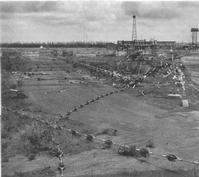


Chapter 8
I Part 1: Communications
i Before the Telegraph
ii Electrical Communication Before Federation
iii Federation to the End of the Second World War
iv Post-war and on to 1975
v 1975 ONWARDS
II Epilogue
III Part 2: Early Australian Computers And Computing
IV Acknowledgements
References
Index
Search
Help
Contact us

Post-war and on to 1975 (continued)
Attention then began to turn to digital coding and transmission techniques, utilising the advantages of solid state electronics. During the 1970s this work was extended to characterising the analogue network for later conversion to digital working, establishing design rules for the expanded use of Pulse Code Modulation (PCM) systems in the junction network and developing digital transmission performance measuring techniques and equipment. This work culminated in the adoption by the CCITT in 1982 of a technique embodied in an invention by Dr. A. J. Gibbs, for the characterisation of the crosstalk performance of digital line systems. Tests on data transmission at speeds of up to 2400 bit/sec over the switched analogue telephone network began in 1962 as the first step in investigations which assisted in the introduction of the Datel service and more advanced services later on. Another project directly related to improving telecommunication facilities in remoter areas saw the Laboratories design and built a 24 channel 2 KHz spaced FDM Channel Doubling System to provide temporary relief to the previously overloaded 12 channel open wire system in service in North Western Australia. Satellite technology was also given close attention, including the possibility of using this technology for improving services in outback areas. Studies of liquid filled optical fibres, invented by CSIRO, began in 1971 and the work was later extended to multi mode and single mode solid glass fibres.In 1972 the Laboratories developed a prototype Video-conferencing system which underwent successful trials via satellite link between Australia and the U.K. in 1973 and was later installed between Melbourne and Sydney. Amongst the many other activities and projects undertaken by the Laboratories was important development work on a solid state SPC exchange which utilised digital techniques to integrate switching and transmission functions. The exchange was installed in the Melbourne network and carried live traffic successfully for a number of years in the course of further studies of digital switching techniques, processor loading, maintenance techniques and traffic flows in SPC digital exchanges.
The projects and studies briefly described indicate some of the major interests of the Laboratories, which worked also on an extensive range of inquiries, some dealing with isolated problems and others of a major nature. In 1975, for example, 88 Research Laboratory reports were issued, as well as 74 Branch Reports and 110 Papers or Lectures were delivered on matters under investigation.
While theoretical studies and investigations of radio propagation were being undertaken, the broadcasting system continued to expand, utilising outputs from these studies. Radio Australia's installation at Shepparton was developed and equipped with a comprehensive radiating system and a sophisticated switching system which enabled any transmitter to be connected to the appropriate aerials to suit the frequency and direction desired. In 1969, in order to increase signal strength and thus provide for improved reception in the Asian region, a high powered booster station was constructed on Cox Peninsula, Darwin, using log periodic aerials and computer controller transmitters to provide a very advanced system. Cyclone Tracey demolished the aerials in 1974 but they were rebuilt in 1984.

Organisations in Australian Science at Work - Australian Post Office (A.P.O.); CCITT (International Consultative Committee for Telephony and Telegraphy); Radio Australia
People in Bright Sparcs - Gibbs, A. J.
 |
Australian Academy of Technological Sciences and Engineering |  |
© 1988 Print Edition pages 567 - 568, Online Edition 2000
Published by Australian Science and Technology Heritage Centre, using the Web Academic Resource Publisher
http://www.austehc.unimelb.edu.au/tia/551.html